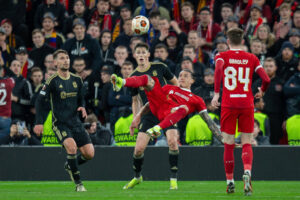The handball rule is one of the most discussed in the beautiful game. Recently, the discussion picked up once again after a pair of incidents involving Liverpool FC. The first came in the first leg of their triumph over Roma to reach the Champions League final. The second came just days later, as the Reds drew 0-0 against Stoke City.
Time to Update the Handball Rule?
What FIFA Says
The handball rule is detailed on page 121 of the FIFA Laws of the Game. The wording is as follows:
“Handling the ball involves a deliberate act of a player making contact with the ball with the hand or arm.
The following must be considered:
- the movement of the hand towards the ball (not the ball towards the hand)
- the distance between the opponent and the ball (unexpected ball)
- the position of the hand does not necessarily mean that there is an offence
- touching the ball with an object held in the hand (clothing, shinguard, etc.) is an offence
- hitting the ball with a thrown object (boot, shinguard, etc.) is an offence”
Note how subjective the verbiage is in the official rulebook. Instead of detailing specifics, the game’s governing body gives a broad definition of what constitutes a handball.
For example, the rule simply instructs referees to “consider” the distance between the opponent and the ball. What this leaves out is just how much reaction time an average professional footballer would need in order to avoid an on-rushing shot.
Such gaps, be they intentional or otherwise, leave plenty of room for the individual referee’s judgement. To illustrate this point, have a look at these two calls.
James Milner Incident
With Liverpool up by a massive 5-1 scoreline, the Champions League semi-final looked over already in the 85th minute of the first leg. However, Roma did not give up. Radja Nainggolan received a cross from his left, firing a shot toward goal.
James Milner threw himself towards the ball in an attempt to make a block. The shot took a deflection off of his arm, causing the referee to point to the spot.
This call made waves as many fans and pundits agree that Milner did not have enough time to get out of the way. However, as there is no recourse to reverse the decision, the penalty stood and Roma were back in the tie.
Erik Pieters Incident
Just days later, Liverpool were back in action against Stoke City. With the game still goalless and time running out, Mohamed Salah played Georginio Wijnaldum into the opposition box.
The midfielder took the ball first time, trying to send a cross into a teammate. However, Erik Pieters covered and blocked the cross, with a little help from his left hand.
There was no penalty call, and the Reds walked away with just one point. Meanwhile, fans and pundits questioned the call, as Pieters’ hand stood in much the same fashion as Milner’s earlier in the week.
Subjective Interpretation
By leaving so much to interpretation with the laws of the game, FIFA places a huge burden on the shoulders of the matchday official. This forces referees and their assistants to make major decisions on what information they have at hand.
The results are varied, as is evidenced by these two incidents. However, fans and pundits consistently find themselves in disagreement over such calls.
For example, how many times are pundits asked, ‘was that a handball for you?’ or perhaps, ‘do you think that looked like a penalty?’ Such subjective wording in the rulebook assures no one person can be objectively correct about the handball rule.
Time for Change?
If FIFA, or perhaps UEFA or the English FA, were to redefine the handball rule, some measure of clarity can be gained.
For example, the laws of the game dictate that the referee must consider the distance between the opponent and the ball when calling or not calling handball. Instead, the governing body could state that if a defender is within ‘x’ number of yards of the opponent with the ball and the ball strikes their hand, it is not a handball.
This would make future handball calls a matter of black and white rather than shades of grey. Alternatively, VAR may play a role.
As more and more leagues integrate the video review system, the possibility of using it for more than goals expands. While it would not be as fast on game day as a change to the rules, this could eliminate the extremely subjective nature of current handball calls.
Regardless of what the change looks like, the handball rule certainly needs change.
Main Image Credit:
Embed from Getty Images






